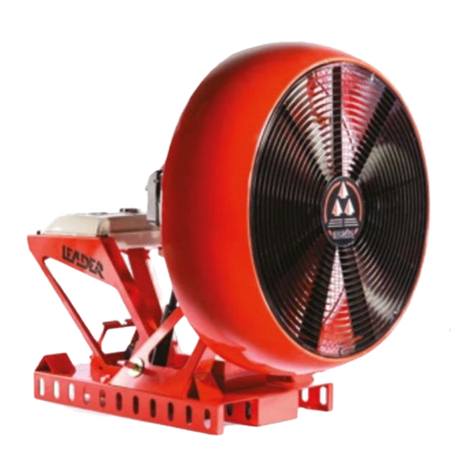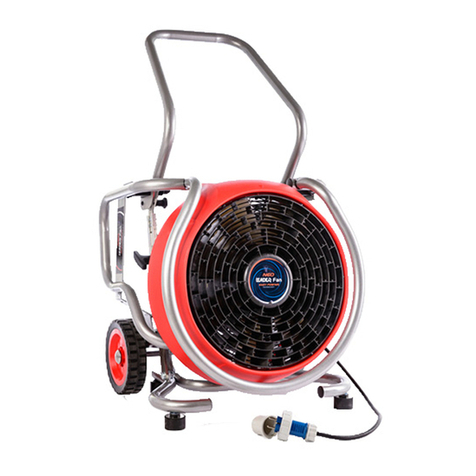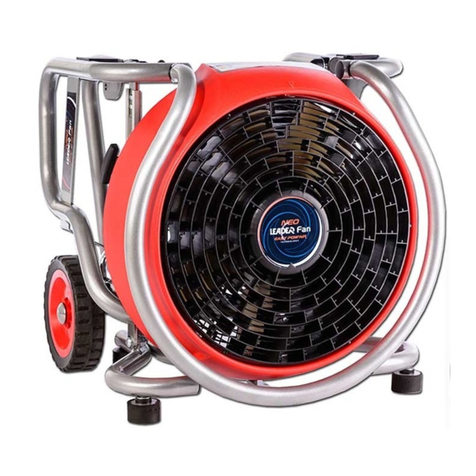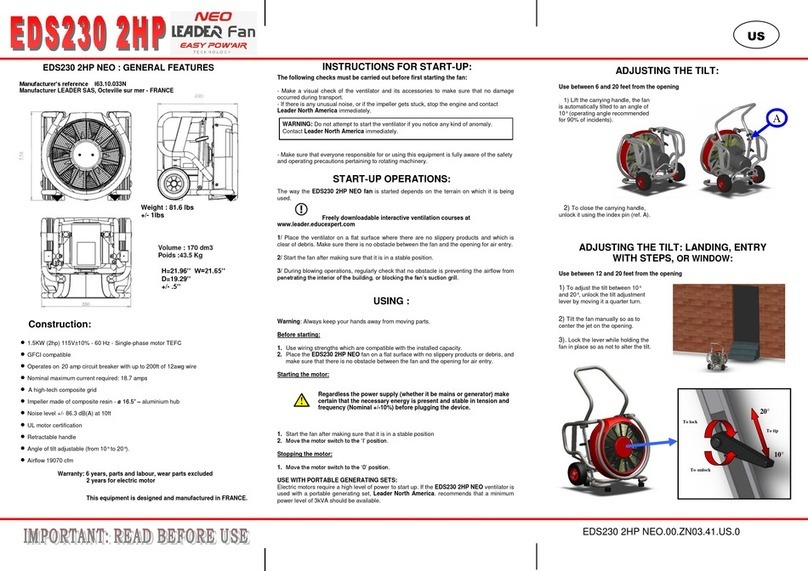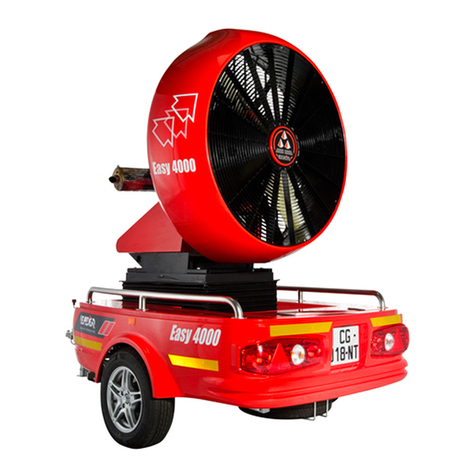Le présent fascicule a été réalisé afin de vous familiariser avec l'emploi de votre ventilateur ESP280.
Les consignes d’utilisation et de sécurité doivent être suivies pour prévenir tout incident. Toutes les opérations
de démontage ou de réparation doivent être réalisées par LEADER ou par un revendeur agréé.
Ce manuel mettra en évidence la simplicité d'utilisation et d’entretien du ventilateur ESP280.
Afin d'améliorer ce livret,
LEADER, reste ouvert à vos suggestions ; n'hésitez pas à nous les communiquer.
1CONSIGNES DE SÉCURITÉ
❖CONSIGNES D’UTILISATION
•Ce matériel est construit conformément aux directives CE. Son utilisation est réservée aux professionnels de l’incendie.
•LEADER, ou ses filiales, déclinent toute responsabilité pour tous dommages directs, indirects ou accidentels, liés à
la fourniture, à la performance ou à l’utilisation de l’appareil.
•Lire entièrement ce manuel ainsi que les instructions d’utilisation et de maintenance moteur jointes avant la mise
en service et l’utilisation du matériel.
•Garder les doigts et les mains à l’écart de la turbine.
•Contrôler les éventuels dommages survenus sur le ventilateur avant et après chaque période de fonctionnement.
•Ne pas démarrer le moteur si les pales ou l’enveloppe présente des signes de dommages.
•Ne jamais déplacer le ventilateur lorsque celui-ci fonctionne à plein régime.
•Les ventilateurs soufflants type ESP ne doivent pas être utilisés dans des atmosphères explosives.
•Tenir l'environnement exempt de pierres, sable, gravats et autres, qui pourraient être aspirés par le ventilateur et provoquer
de graves blessures.
•Ne pas rester dans la zone de refoulement du ventilateur (risque de projections).
•Tenir l’appareil à l’écart des enfants et animaux.
•Porter des lunettes de protection, des gants et un casque antibruit lors de l’utilisation du ventilateur.
•Ne jamais autoriser une personne à utiliser un ventilateur sans lui avoir fourni les instructions nécessaires.
•Ne pas porter de vêtements trop lâches qui pourraient être happés par le ventilateur.
•Ne pas utiliser de cales ou autres systèmes pour augmenter l’inclinaison du ventilateur.
•Utiliser uniquement les accessoires prévus et validés par LEADER.
❖CONSIGNES D’ENTRETIEN ET DE MAINTENANCE
•Ne faire fonctionner ou réparer ce ventilateur que par du personnel qualifié et formé sous risque d’annulation de garantie.
•Toujours remplacer une pièce défectueuse par une pièce d’origine fournie par LEADER.
•Durant les opérations d’entretien, mettre l’appareil hors tension.
2CARACTÉRISTIQUES GÉNÉRALES
•Châssis tubulaire en Acier de Ø 30 mm - Peinture Époxy.
•Démarreur progressif intégré.
•Électrique 7.5kW -15.5A (en régime établi) et 32A en courant
de démarrage.
•Alimentation : 400V - 50Hz triphasé 3p+N –IP55.
•Carter de protection du ventilateur en tôle Aluminium de 3 mm.
•Turbine en résine composite - Ø 570 mm.
•Niveau sonore de l’ordre de 96.3 dB(A) à 3 m.
•Poignée de transport escamotable, deux roues Ø 230 mm.
•Réglage de l’angle d’inclinaison (de 10 à 20°).
•Débit d’air : 115 700 m³/h.






